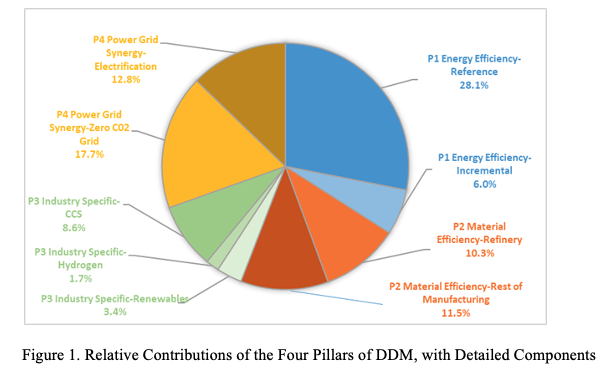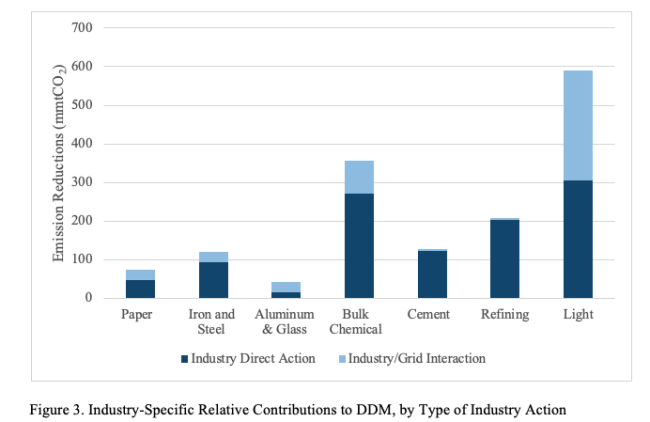With industry accounting for more than 25% of U.S. greenhouse gas emissions, its decarbonization will be crucial for meeting U.S. climate goals. Yet industry is not as easy to electrify as other parts of the U.S. economy, because some of its processes require higher temperatures than electric heat pumps can currently handle. So, how much and how quickly can industry really decarbonize?
The U.S. Environmental Protection Agency (EPA) offers an estimate in a paper to be presented at next month’s biennial Summer Study on Energy Efficiency in Industry. The EPA analysis is one of more than four dozen papers that this 14th biennial event, hosted virtually this year, will publish on technologies, policies, and programs to reduce industry’s energy use and emissions.
“This analysis shows that many different approaches are needed to achieve deep decarbonization by 2050,” says Elizabeth Dutrow, the founding manager of EPA’s ENERGY STAR Industrial Partnerships, former Summer Study panel leader, and long-time conference contributor. “Industry needs to start now,” she adds. Dutrow co-authored the paper with Gale Boyd of Duke University, Josh Smith of consulting firm ICF, and Ernst Worrell of Utrecht University — all long-time conference contributors.
The authors estimate the potential for reducing carbon dioxide emissions from U.S. manufacturing overall and in the seven most carbon- and energy-intensive industries. They used the U.S. Energy Information Administration’s (EIA) Annual Energy Outlook as their Reference Case forecast of industrial activity and combined it with a review of literature on industrial emissions technologies and practices.
I reached out to Dutrow to get a preview of their findings. Here are excerpts of our conversation:
In EPA's assessment, how much industrial decarbonization is possible by 2050?
Our evaluation estimates a reduction potential of 86% from EIA’s estimated level of industrial emissions in 2050. While we did not evaluate the timing of specific actions between now and 2050, there are logical time periods for certain activities. For example, energy efficiency is important now and into the future, whereas electrification will depend on appropriate pricing and a decarbonized grid.
Which pillars or areas deliver the biggest carbon reductions?
We looked at four pillars of deep decarbonization of manufacturing or DDM, as shown in the figure below:
- energy efficiency.
- material efficiency (structural changes in manufacturing such as product recycling and reuse, material substitution, and demand reduction).
- industry-specific technology (e.g., carbon capture, storage, and utilization; hydrogen; and non-power generation renewables).
- power-grid synergies (shift to a zero-carbon grid and beneficial electrification of fuel-consuming processes).
No single pillar dominates deep decarbonization across all industrial sectors. Among the pillars examined, energy efficiency’s contribution is the largest (34%), followed by power grid synergies (30%), material efficiency (22%), and industry-specific technologies (14%).
The evaluation shows that energy efficiency has been and will continue to be an important strategy going forward, as it not only impacts emissions, but will provide savings and reductions that prepare the way for the remaining pillars to be more attainable. New energy efficiency opportunities include improved plant component design, increased optimization of production processes, enhanced waste heat recovery, etc.
What are the biggest obstacles to reaching this 86% reduction by 2050?
There are many. Obviously, ready-to-deploy technology and available funding are important. Broadly, though, decarbonization of all of industry must be a goal and high priority. Our evaluation shows that a handful of energy intensive sectors (e.g., iron and steel, chemicals, cement, shown in the figure below) have multiple opportunities to decarbonize significantly by 2050. However, the remainder of industry, a group of sectors we labeled “light industry” could provide 39% of the decarbonization in 2050.
Light industry includes manufacturing sites that produce items from baked bread to vehicles to cast metal parts, and these businesses range from large to small in size. Light industry tends to rely on electricity and natural gas to power operations. With a decarbonized grid, it is easy to imagine the carbon emissions prevented as a fully energy-efficient, light industrial sector draws from that grid. But, to get there by 2050, disincentives such as inexpensive natural gas and lack of supporting infrastructure need to be addressed. Finally, we believe light industry is in a good position to make use of renewable energy as the process temperature needs often are much lower than the energy-intensive sectors.
What needs to happen now to overcome the obstacles and rapidly decarbonize?
Decarbonization of the industrial sector needs to grow extensively to take advantage of the time available and the savings that energy efficiency provides to help fund action among all of the pillars. Industrial decarbonization should be approached with the view that all available options are necessary. Certain opportunities reduce the cost of others, while some reduce emissions to a more manageable size so that new technologies can play their important role. Finally, while many companies are setting long-term carbon reduction goals, they also need to commit funds to meeting their decarbonization targets.







